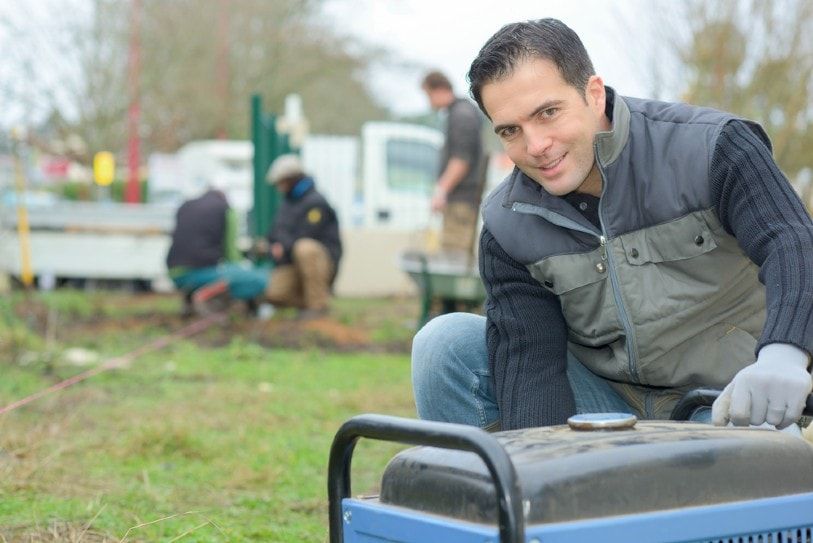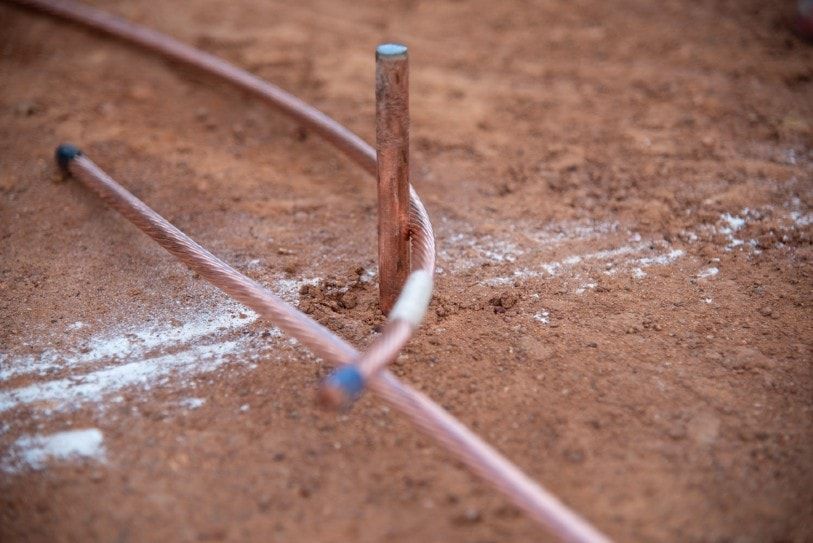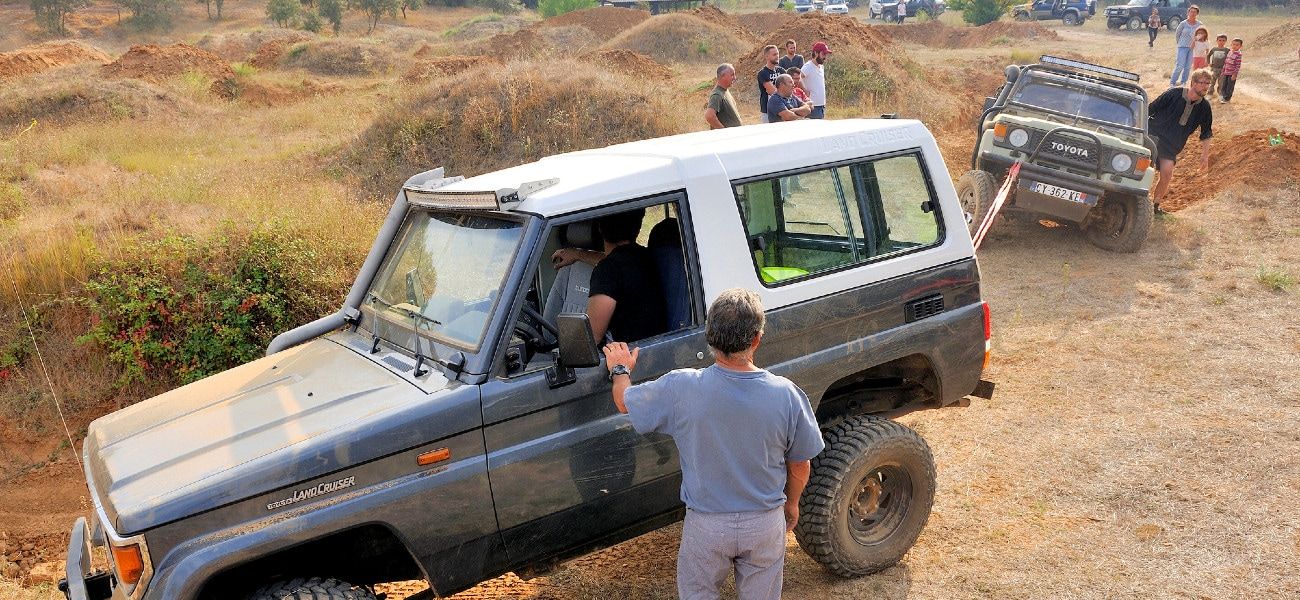Have no idea how to ground a portable generator?
This article will teach you everything you need to know about grounding a generator, what it means, the tools you need, and the process of doing it.
IMPORTANT NOTE: The advice below is general in nature and cannot cover every possible make and model of generator. You should always consult your operating manual and follow all instructions contained within.
This guide is a good primer on generator safety.
What Does Grounding A Generator Mean?
Simply put, grounding or earthing a generator means connecting an electrical system such as a generator to an electrode buried in the ground. This is done to dissipate electrical currents in the event of a power surge.
In other words, the grounded electrode acts as a path of least resistance for electricity to flow. So instead of the excess electrical currents flowing through you or your device (potentially causing electrocutions, fires, or damage to appliances) it flows to the ground where it is dissipated.

Do You Need to Ground Your Portable Generator?
It is common knowledge that all generators have to be grounded to be safe. However, whether or not you have to do something to ground it is the real question you’re asking.
Not all portable generators require you to do anything to ground them. In modern generators, the generator itself is bonded to the metal frame which acts as the ground.
The easiest way to tell whether or not your generator requires grounding is by asking the manufacturer or checking the owner’s manual.
If you cannot do that, there is another way of checking.
Generators that are separately derived systems require grounding. On the other hand, generators that are NOT separately derived systems do not need grounding.
To know whether or not your generator is separately derived, simply check the generator’s transfer switch and look for the option to transfer to a neutral ground conductor.
- If the transfer switch gives you the option to transfer to a neutral ground conductor, it is a separately derived system and would need to be grounded
- If it does NOT, it means it is unseparated and does not need to be grounded
Tools You Need For Grounding Your Generator
Here are the tools you need for grounding.
Copper Ground rod - This is the electrode that will be buried in the ground where the electrical current will be dissipated. Grounding rods are typically over 1 metre in length.
Copper Grounding Wire - Connects the generator to the grounding rod. The length will depend on how far away you set up your grounding rod.
You will also need a copper ground clamp to attach the copper wire to the ground rod.
Hand Tools - Used for the process of burying the ground rod and connecting the wires.
- Wire strippers
- Pliers
- Wrench
- Hammer or mallet
How To Ground Your Portable Generator?
Make sure the generator is turned off while you’re going through this process.
Step 1: Bury the copper ground rod
Using your hammer or mallet, bury the ground rod vertically at least 2-3 metres deep into the ground.
The difficulty of this step will depend on the type of ground you’re burying the rod. For rocky or hard surfaces, you can bury the rod at an angle not exceeding 45 degrees.

Step 2: Attach the copper wire to the ground rod
Attach the copper wire to the ground rod using a ground clamp. You may need to use a wire stripper to strip rubber off your copper wire.
Make sure you strip just enough so it doesn’t expose too much copper. Use your wrench to tighten your grounding clamp.
Step 3: Connect the other end of the copper wire to the generator
Lastly, extend the wire to the generator and connect the copper wire to the appropriate grounding location.
Use the wrench to loosen and tighten the bolts and the pliers to tightly wrap the wire around it.
Conclusion
Grounding a generator is very important for safety reasons. With the proper tools and by following the steps outlined in your owner’s manual, it can be a straightforward task.
Remember that many modern generators are already grounded and don’t require you to do anything in particular.
This article may contain affiliate links. I will earn a commission if you choose to purchase a product or service after clicking on my link. This helps pay for the cost of running the website. You will not be disadvantaged in any way by using my links.
Note that while every effort is made to ensure the accuracy of the information on this page, there may sometimes be errors. Check all specifications with the manufacturer before purchasing any product.




Wow , I am reading these instructions. Bought a generator for boondocking. To ground it just drive a copper rod 4 to 8 feet into the ground, make sure the ground isn’t wet, if the ground is to hard pour water on it to wet it(???). Does that mean if it rains you can’t use generator until ground dries. After I’ve been at this spot for a day or two and am ready to move on how do I get my ground rod(driven4-8 feet into the ground) back , and let’s say the hulk isn’t camping with me. Do I leave these behind and make sure my camper is loaded with spares.
Hi Rick,
What Make/Model is your Generator ?
Does your Generator have a RCD Breaker (Safety Switch as opposed to a standard Circuit Breaker) If you’re not sure then see if you can find a Part Number on the “Breaker”.
Are you connecting the generator to a “Inlet” on a Caravan, or just using an Extension lead to a Power Board, with a few appliances connected off it ?
Are you using the Generator in conjunction with a Solar Hybrid Inverter/Batteries ?
There are a lot of variables to consider before making a determination on the best solution for Earthing. In general, I would not be driving a Earth Rod into the ground 4-8 feet every time you pull up for a night or two. As you mention, the recovery alone would be near impossible. However, bonding the generator to a metal water pipe, or other metal object driven into the ground….even a post support bracket for a picnic shelter….can’t hurt, but not essential. 🙂 Remember, it’s for Electrical Surges, typical from Lighting.
That said, you need to understand what an Earth Rod actually does, and how it can help you. As per the article, and the end of the day, an Earth Rod is used to protect you from “Electrical Surges” typically caused by Lightning….END OF STOREY !!!! When a lightning bolt is trying to find it’s way to Earth, you don’t want it through your equipment, you want a direct path through a good conductor into the Earth. So if there’s no lightning around, I think you can make your own determination.
From my comment above, I’m going to have a lot of comments back from people stating that an Earth is there to stop you getting electrocuted…bla…bla…bla. To those people, you’re wrong, and I would recommend you read up on theory of Electrical Installations and why/how Earthing systems are employed. Happy to have a more detailed discussion about this 🙂
In relation to “Moisture Content”….the best situation is to have the best conductance into the earth as possible. So being damp/wet ground is a good thing. Not only does it achieve good conductance, but makes it easier to drive a rod into the ground…if you so choose.
Regards
Jeff
Dear Louis, modern portable generators are plastic case housed. No earthing available as also double isolated. I agree with Jeff, toting an earth rod is ludicrous. In central Aus, the ground is like concrete – try driving a tent peg in! (I have many bent ones.) I encountered this silly problem when looking at generators for emergency lighting on main roads – drive an earth rod into the bitumen? I don’t think so. This issue of generators/inverters and eathing, RCD’s, RCBO’s etc., is the most confusing issue with many ‘professionals’ disagreeing on the subject. AS3001:2008 (Amended Feb 2023) states applicable to caravans, re-locatables, including tents. No definitions of the former are listed. Also, the Grid distributer/suppliers have stated that if the ‘appliance – e.g., caravan, re-locatable etc., are not connected to the grid, then they have no juridisction – in other words ‘go away’!
(Former employee State Electricity Comm (VIC), former employee Prospect County Council (NSW) and much travelled in Australia camping, 4WD etc.